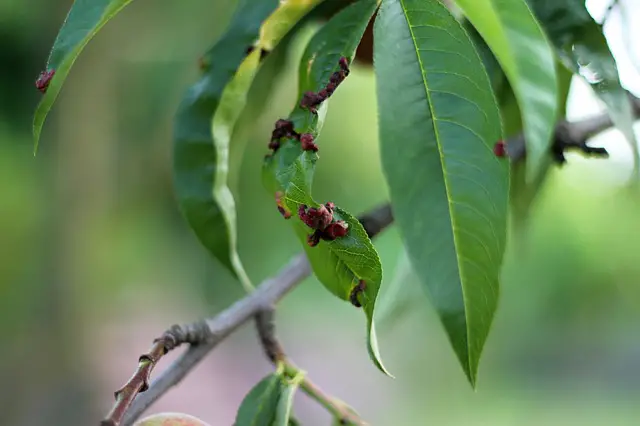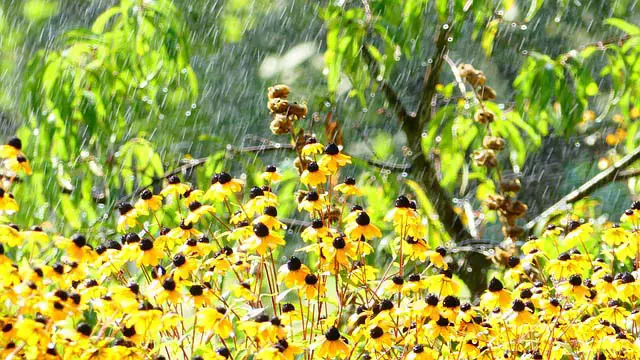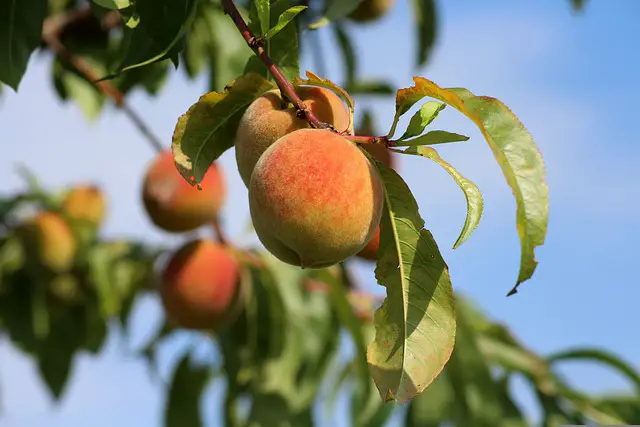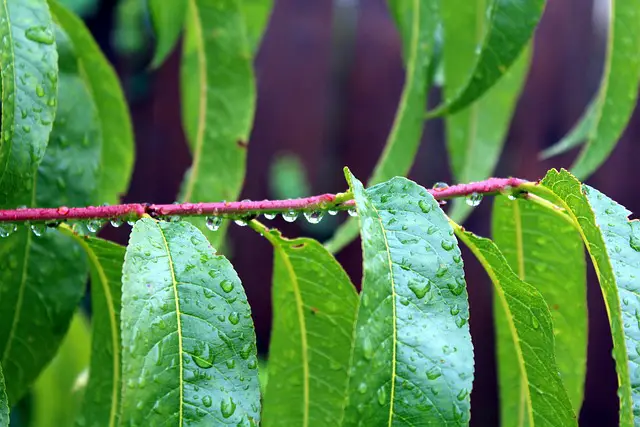
We may receive commissions from purchases made through links in this post, at no additional cost to you.
Peach trees are notorious for becoming victims of various diseases and pests. The twisting, warty look of curling peach tree leaves can scare even an experienced gardener. But will it affect the overall health of the tree? Is there anything that can be done to control the spread of leaf curl on peach trees?
Curling leaves on a peach tree indicate infection with the fungal disease known as peach leaf curl. The best treatment for this disease is prevention by spraying with a copper fungicide during the dormant season. Leaf curl can decrease peach production but is rarely fatal to peach trees.
With a little bit of understanding about how peach leaf curl spreads and shows symptoms, a gardener can easily minimize (or even eliminate!) issues with this fungus. Continue reading to find out why leaf curl develops, its effect on peach trees, and how to manage and prevent infections.
What causes peach leaf curl?
Peach leaf curl is caused by the fungus Taphrina deformans, which causes the leaf cells to divide and grow larger than usual. The cells take on a reddish appearance and show up on the plant as thick, velvety-looking distorted spots.
Symptoms of peach leaf curl start showing about two weeks after the leaves first emerge. First, red spots will be visible, then the leaves will thicken and distort into curly, twisted shapes. As the infection continues, the thickened areas will turn a velvety grayish-white. Eventually, the leaves will turn yellow or brown and fall off the tree.
As the name indicates, peach leaf curl typically only affects the leaves and young green twigs or shoots of a peach tree, but it may affect flowers and fruit as well. The fungus stunts the growth of new shoots and causes them to thicken, distort, and eventually die. A very bad infection may cause flowers to quickly wilt and fall off or may show on the fruit as reddish, wrinkled areas or bumpy, cracking spots on the skin.

Leaf curl fungus loves wet, cool weather. Spores will survive the heat of summer to germinate in the mild, wetter weather of fall, then show symptoms of infection in the spring. Peach leaf curl tends to show up more when there is a stretch of wet weather in the spring when leaves are first emerging.
Will peach leaf curl go away by itself?
The peach leaf curl fungus will stop developing once the weather dries and heats up past about 80°F. After the initial infected leaves fall off the tree, new healthy leaves will emerge unless wet, cool weather continues the fungal growth.
The fungus may stop infecting leaves once the summer heat kicks in, but the fungal spores will survive hot, dry weather. Just because symptoms no longer show doesn’t mean that the tree isn’t still infected by peach leaf curl. Once the weather cools down and fall rainfall starts, the spores will germinate again.
When the diseased leaves fall and the tree starts growing a second round of leaves, that year’s peach production will be set back dramatically. If the tree’s resources are being used to form a whole new set of leaves late in the season, then it will not have the energy to produce and ripen fruit. The tree basically has to start the growing season over, much later than usual.
Defoliation (the dropping of leaves) due to peach leaf curl could also lead to sunburn injury on the branches, especially since the end of leaf curl symptoms corresponds to the arrival of hot weather. (Did you know trees can sunburn? Read more about this here.)
Luckily, even after a pretty bad leaf curl infection, most trees will bounce back the next season with few issues. Repeated bad infections over several years may weaken the tree, however, so it’s best to take some preventative measures.
How do you prevent or treat leaf curl in peach trees?
A peach leaf curl infection may look disastrous for the tree, but it actually isn’t hard to manage or prevent. There are some easy things you can do to keep peach leaf curl from causing big problems for your peach trees.
Choose a Leaf Curl-Resistant Peach Variety
Below are a few peach and nectarine varieties that are resistant to the leaf curl fungus. Some cultivars are naturally resistant to leaf curl infection, and others are simply hardier or more tolerant of the fungus and are less susceptible to symptoms of infection. Make sure to choose a variety that is well-suited to your growing zone and number of winter chill hours.
- ‘Frost’
- ‘Q-1-8’ or ‘Salish Summer’
- ‘Oregon Curl Free’
- ‘Avalon Pride’
- ‘Indian Free’ (note: needs to be planted near another peach tree for pollination)
- ‘Muir’
- ‘Autumn Rose’
- ‘Charlotte’
- ‘August Etter”
- ‘Early Crawford’
- ‘Nanaimo’
- ‘Curlfree’
- ‘Pacific Pride’ (nectarine)
- Kreibich (nectarine)

Even leaf curl-resistant peach trees can benefit from preventative measures such as pruning and spraying with a fungicide, particularly if you live in a very humid or wet climate. Read on for details about spraying to prevent leaf curl.
When to Spray for Peach Leaf Curl
To prevent leaf curl on peach trees, spray a copper-based fungicide in the dormant season soon after leaves have fallen. This will occur between late November (for cooler, northern climates) and mid-January (for warmer, southern climates).
Spraying with a fungicide such as Monterey Liquid-Cop Copper Fungicide Spray is the best way to reliably prevent peach leaf curl infections. Fungal spores will overwinter on peach trees, so spraying in dormancy kills the spores and keeps them from germinating in the spring.
Spray the tree thoroughly, covering all surfaces until the tree is dripping. Remember the trunk and the ground below the tree, as well. Don’t spray if rain is predicted in the next couple of days, to avoid the product washing off before it has a chance to be effective. Also, do not spray if the weather is due to drop below 35°F for a couple of days.
Usually, one application of fungicide is enough to prevent infection for the year. If last year’s infection was particularly bad, or if the disease pressure in your area is very high, a second spray can be done late in the dormant season just as the buds are beginning to swell.
Light pruning in the fall reduces the number of fungal spores on the tree, which means you won’t need to spray as much fungicide. Be careful not to prune too much, though, because you don’t want to signal the tree to produce new growth right before the winter. For an easy explanation of good backyard peach tree pruning practices, check out A Simple Guide to Pruning Peach Trees for Maximum Harvest.
To learn more about dormant spraying to prevent peach leaf curl and other pests and diseases, read Dormant Peach Tree Spraying: What, When, and How to Do It.
Can you treat a current leaf curl infection?
There is not really anything you can do to help your tree once symptoms of leaf curl are showing, other than just waiting it out. You can remove infected leaves and shoots, but there is little evidence that this helps to control the spread of the fungus.
Once the infected leaves have fallen, however, remove the fallen debris from the ground. Bag up the infected leaves, twigs, branches, and fruit – never put diseased plant tissue in a compost pile.

Wetness due to humidity, rainfall, irrigation, or even dew can encourage peach leaf curl to spread. Infection will worsen if the tree stays wet for more than a day or two. Avoid using sprinklers or accidentally spraying the leaves with water, as a wet environment encourages the fungus.
Once there are leaves on the tree and the weather is beginning to warm, it’s too late to spray a fungicide. Wait until the leaves drop before spraying. Good treatment in the dormant season should help the tree bounce back the following year.
Do what you can to reduce stress on infected trees. Water deeply and regularly, depending on rainfall – aim for about an inch of water per week. Prune the tree every year to encourage healthy growth and peach production. If necessary, apply a fruit tree-specific fertilizer once in the spring and again as the fruits are developing.
The good news is, peach leaf curl is rarely fatal for peach trees. A little bit of prevention makes the disease easy to control, and your peach tree will show few ill-effects in the long term.

